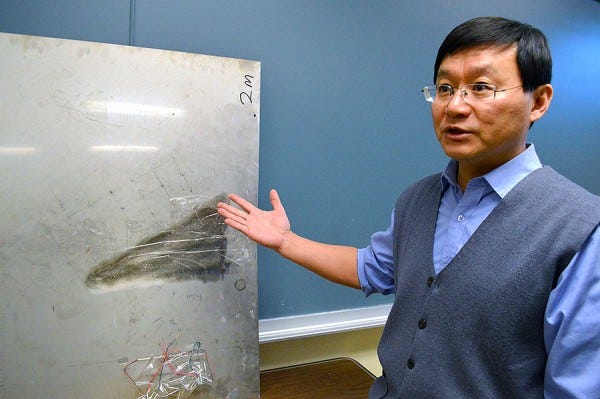Elastic Waves Boost Medical Imaging
January 23, 2015
Elastic waves are an interesting breed of acoustic sound waves that pass through objects leaving a trail of ripples and shockwaves in their path. These elastic waves travel at the surface, or even through material, without causing any permanent changes to the makeup of the substance. In recent years, researchers have been studying these elastic waves, in the hopes of understanding how they move through materials in an effort to better control them to our benefit.
Recently, researchers from the University of Missouri developed a material that has the ability to control these elastic waves, a breakthrough that could potentially have a significant impact on medical imaging, according to a news release from the university. Guoliang Huang, associate professor of mechanical and aerospace engineering and leader of the study, spoke to university news about the potential impact of their work.
|
Huang and his metamaterial that refracts acoustic and elastic waves"> |
"Methods of controlling and manipulating subwavelength acoustic and elastic waves have proven elusive and difficult," Huang said. "However, the potential applications -- once the methods are refined -- are tremendous. Our team has developed a material that, if used in the manufacture of new devices, could have the ability to sense sound and elastic waves. By manipulating these waves to our advantage, we would have the ability to create materials that could benefit society greatly."
The material was made in a single steel sheet, using lasers to engrave geometric microstructure patterns that are asymmetrical to their mirror images. It's the first such material to be made out of a single medium, and Huang and his team plan to introduce the elements they can control in order to prove its usefulness in many different fields and applications.
In the past, scientists have typically used a combination of metal and rubber to effectively "bend" and control waves. Huang and his team designed a material using steel as a single component. This engineered structural material possesses the ability to control the increase of acoustical and elastic waves, making improvements to broadband signals and super-imaging devices possible.
Researchers have been studying sound waves for years in an effort to better understand how they react to different structures. Just last year researchers from North Carolina State University developed a technique that enables ultrasound waves to penetrate bone and metal, using custom structures that offset distortion resulting from the waves that get blocked by bone. The technique was the result of an intricate analysis of how high frequency waves react when bounced off of an object, something Huang and his team have focused on as well.
"We're going to make this material much more active by integrating smart materials like microchips that are controllable," he said. "This will give us the ability to effectively 'tune in' to any elastic sound or elastic wave frequency and generate the responses we'd like. This manipulation gives us the means to control how it reacts to what's surrounding it."
As for the future, Huang believes there are numerous possibilities for the material to control elastic waves including super-resolution sensors, acoustic and medical hearing devices, and even a "superlens" that could significantly enhance super-imaging. As exciting as all of these potential applications are, none of them would be possible without the ability to more directly focus and manipulate elastic waves, something Huang and his team hope to pioneer through their continued research.
Refresh your medical device industry knowledge at MD&M West, in Anaheim, CA, February 10-12, 2015. |
Kristopher Sturgis is a contributor to Qmed and MPMN.
Like what you're reading? Subscribe to our daily e-newsletter.
About the Author(s)
You May Also Like



